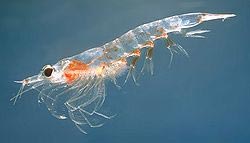: Euphausia pacifica
Phylum Arthropoda
Krill occur in all oceans of the world and most krill species display large daily vertical migrations, thus providing food for predators near the surface at night and in deeper waters during the day.
Krill are crustaceans which have a chitinous exoskeleton These small crustaceans are important organisms of the zooplankton, particularly as food for baleen whales, manta rays, whale sharks, crabeater seals, and other seals, and a few seabird species that feed almost exclusively on them.
|

|
| They are considered keystone species near the bottom of the food chain because they feed on phytoplankton and to a lesser extent zooplankton, converting these into a form suitable for many larger animals for whom krill makes up the largest part of their diet. In the Southern Ocean, one species, the Antarctic Krill, Euphausia superba, makes up an estimated biomass of over 500 million tons, roughly twice that of humans. Of this, over half is eaten by whales, seals, penguins, squid and fish each year, and is replaced by growth and reproduction. Most krill are about 1 to 2 cm long as adults, a few species grow to sizes on the order of 6 to 15 cm .Krill can be easily distinguished from other crustaceans by their externally visible gills. Many krill are filter feeders: their frontmost extremities form very fine combs with which they can filter out their food from the water. These filters can be very fine in those species that feed primarily on phytoplankton, in particular on diatoms, however it is believed that krill are mostly omnivorous. Some few species are carnivorous, preying on small zooplankton and fish larvae.
: Most krill are bioluminescent animals having organs called photophores that are able to emit light. The light is generated by an enzyme- and probably do not produce this substance themselves but acquire it as part of their diet that contains dinoflagellates. Krill photophores are complex organs with lenses and focusing abilities, and they can be rotated by muscles. The precise function of these organs is as yet unknown; they might have a purpose in mating, social interaction or orientation.
There are concerns that the overall biomass of Antarctic krill has been declining rapidly over the last few decades. Some scientists have speculated this value being as high as 80%. This could be caused by the reduction of the pack ice zone due to global warming Antarctic krill, especially in the early stages of development, seem to need the pack ice structures in order to have a fair chance of survival.Another challenge for Antarctic krill, is the Acidification of the oceans caused by increasing levels of carbon dioxide. Krill exoskeleton contains carbonate, which is susceptible to dissolution under low pH conditions. Little is currently known about the effects that ocean acidification could have on the krill but it is feared that it could significantly impact on its distribution, abundance and survival as it appears to have effects on its ability to moult and grow or its behavioural patterns.
|